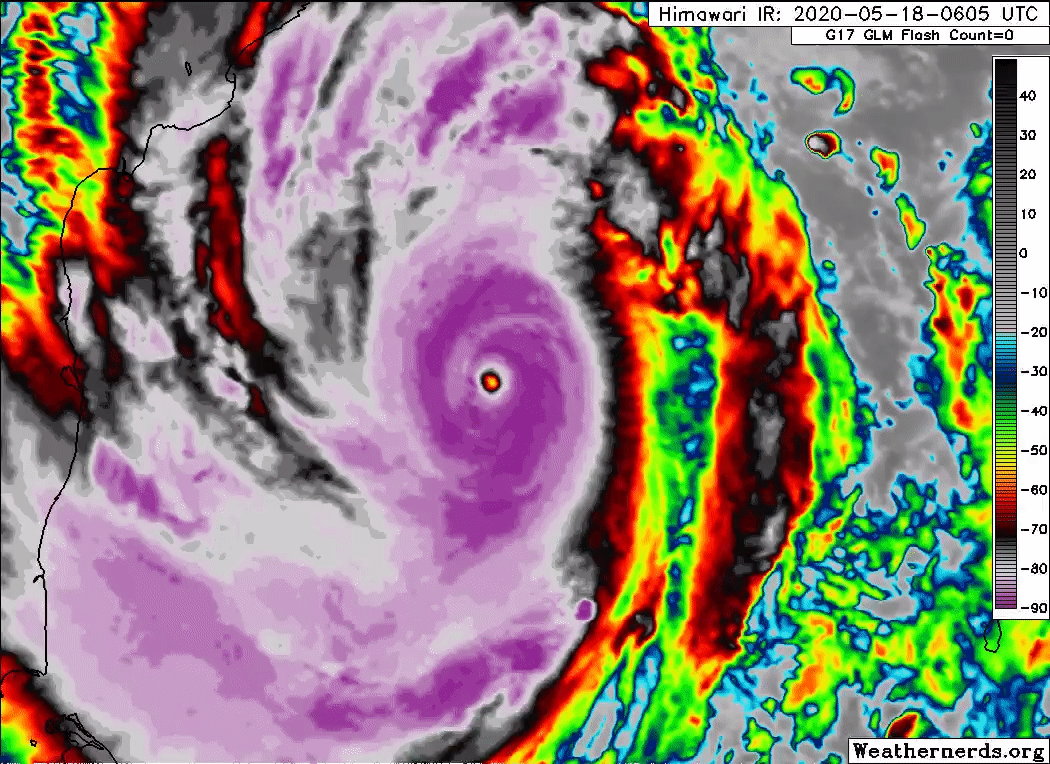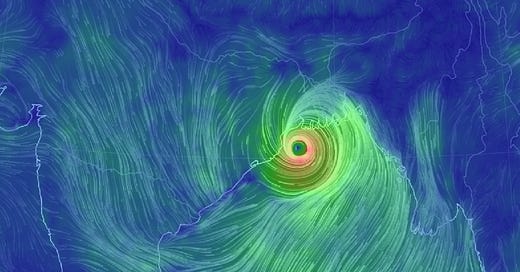#3 - What's supercharging Amphan
Record ocean temperatures in the Bay of Bengal are puzzling scientists: "We have never seen such high values until now"
Hello and welcome to this week’s early edition of Lights On, a newsletter that brings you the key stories on energy and climate change in South Asia.
This installment comes to you a day early because of the arrival of a record-breaking cyclone on the coasts of India and Bangladesh.
Double whammy
The cyclone hit India and Bangladesh as they still grapple with the impacts of coronavirus
Scientists expect more intense cyclones in future, as climate change warms the oceans
Cyclone Amphan crashed onto the northeastern coast of India at 2.30pm local time today. As I write this newsletter, half a million people have been evacuated in West Bengal state alone, but about 3.5 million remain vulnerable to the impacts of the storm. West Bengal and Bangladesh are used to facing extreme weather, and they have well honed protocols in place, but this year’s coronavirus epidemic has thrown a spanner in the works. Hundreds of thousands of migrants have been fleeing the cities where the lockdown had put them out of work, and those who made it had to spend two weeks in quarantine.

A rendering of Amphan’s speed and trajectory from the earth.nullschool.net project, earlier today before it hit the coast. Here you can see the progression live.
The same isolation facilities are now sheltering hundreds of thousands of people evacuated from the coast, who hesitated to follow the government’s directive for fear of contagion, explains Anurag Danda, a climate change expert with the Observer Research Foundation currently watching the intensifying storm in Kolkata. “Because of the lockdown, they have not been able to sell their harvest which would be left unattended if they left,” he says.
Has climate change supercharged Amphan?
Beyond the fact that it overlaps with a public health calamity, Amphan is a unique threat in itself, even for regions that deal with frequent cyclones. With a maximum speed of 270km/h, on Monday night it became the strongest storm ever recorded in the Bay of Bengal. Its speed has also increased extremely fast, making it harder for meteorologists to forecast its movements:


There is growing consensus that as the climate changes we are not necessarily going to see a higher number of cyclones, but we can expect them to be much more severe.
“Tropical cyclones form over warm ocean temperatures,” says Roxy Mathew Koll, scientist at the Indian Institute of Tropical Meteorology and a lead author for the latest IPCC report on the state of the oceans and cryosphere.
“The ocean temperatures enhance the upward motion of warm moist air and provide the fuel for cyclone formation,” he explains. As a cyclone forms and grows, high temperatures fuel its rapid intensification, leading to powerful storms such as Amphan.
“In this case, buoys installed in the Bay of Bengal recorded surface temperatures of 32-34°C, prior to the cyclone,” Mathew Koll says. Waters reaching 26°C already have the potential to seed cyclones, but “we have never seen such high values until now,” he says. “These surface temperatures are so high probably because they are riding on the global warming trends in the background.”
Raghu Murtugudde, a climate scientist with the University of Maryland in the US, says that the rapid intensification of cyclones is part of a trend observed in other parts of the world, but warmer waters turbocharge these storms in other ways too: “As they get close to the coast, they're [increasingly] stalling,” he says. With sea level rise, he explains, there is more warm water by the coast, “so the storm just parks itself and doesn’t break apart” as normally happens when a cyclone approaches the land and runs out of energy. “So that dumps a lot more rain.”
Generally, the number of cyclones and their intensity are low in the north Indian Ocean, compared to regions like the west Pacific, Mathew Koll tells me. The Bay of Bengal accounts for only 5% of tropical cyclones, despite claiming more than 80% of the fatalities due to these storms as a result of its population density. Historically, he explains, the intensity of these storms has been low because the bay is relatively narrow and there isn’t enough room for the storm to develop. However, as we are seeing today, “climate change is proving to be a catalyst in intensifying these storms,” Mathew Koll says.
Disaster-proof energy systems
When a cyclone hits, one of the first systems to collapse is the energy infrastructure, because the strong wind immediately uproots electricity pylons. The central government has an emergency plan in place to restore power as soon as it’s safe to do so, but Danda explains that before the centralised grid took over, the Sunderbans, a mangrove area in the stretch of land between India and Bangladesh, was one of the first to have renewable-based microgrids up and running, which are much more resilient to natural disasters. “These models of standalone generation on distribution included biomass gasification, rooftop solar, it had wind, and hybrid systems combining different sources,” he explains.
Although long gone after the advent of large scale electricity distribution, these systems were a great example of disaster-proof energy infrastructure. If well installed, rooftop PV doesn’t fly away with the wind, because it’s closer to the ground. Same goes for other small scale plants that can be kept safe more easily by the communities who own them.
It is likely that soon the record intensity set by Amphan this week will soon be surpassed by another storm, driven by a warming sea. Looking at communities that have lived for generations under the looming threat of extreme weather can teach important survival skills to those who will be affected tomorrow in other parts of the planet.
Hot in the region
Cabinet approves commercial coal mining policy; auctions soon: Sources - Sarita C. Singh, Economic Times
India will soon begin auctioning off coal blocks for commercial mining, putting an end to the monopoly of state-run Coal India - a move that has raised eyebrows among industry associations, trade unions and environmental activists worried that the government may be handing over India’s natural resources to businesses, domestic and foreign.
Hot from the world
IEA releases a global report on the state of renewables after Covid-19
The International Energy Agency analysed the state of play of the renewable sector after the pandemic, and looked at what we can expect in 2021. Unsurprisingly, the lockdown slowed down the construction of power plants across the world, however analysts expect these figures to bounce back in 2021. Worst hit in the renewable world was rooftop solar, followed by wind and utility scale PV, while hydropower is still on the rise, due to two new megaprojects currently underway in China.
'Extreme' effect: Global emissions plummet 17 per cent during lockdown - James Murray, Businessgreen
The first peer-reviewed study on the impacts of the Covid-19 crisis, published this week on Nature Climate Change, estimates that the global lockdown led to a 17% fall in daily carbon emissions, which will likely translate to a 7% decrease for the year 2020. The authors warn that a reduction of such magnitude would be needed every year for decades if we want to keep global warming within the 1.5°C threshold.
German pipeline operators present plan for world’s largest hydrogen grid - Bernd Radowitz, Recharge
German gas pipeline operators have presented a plan to create a 1,200-kilometre grid by 2030 to transport hydrogen across the country, which would be the world’s largest being planned so far.
If you’ve been forwarded this newsletter and you’d like to read it every week, you can subscribe here:



